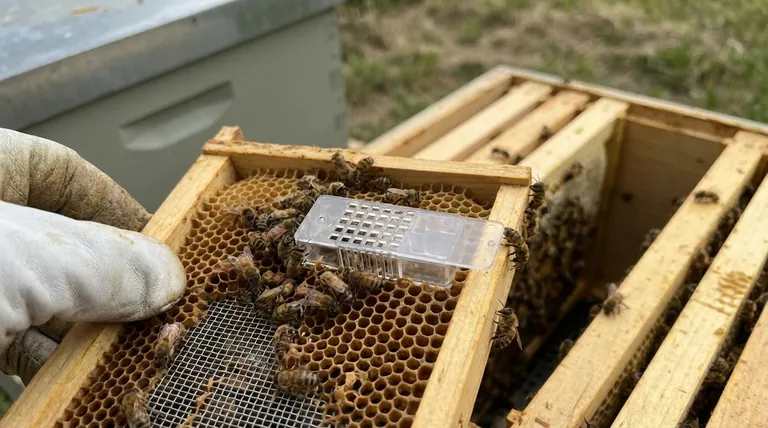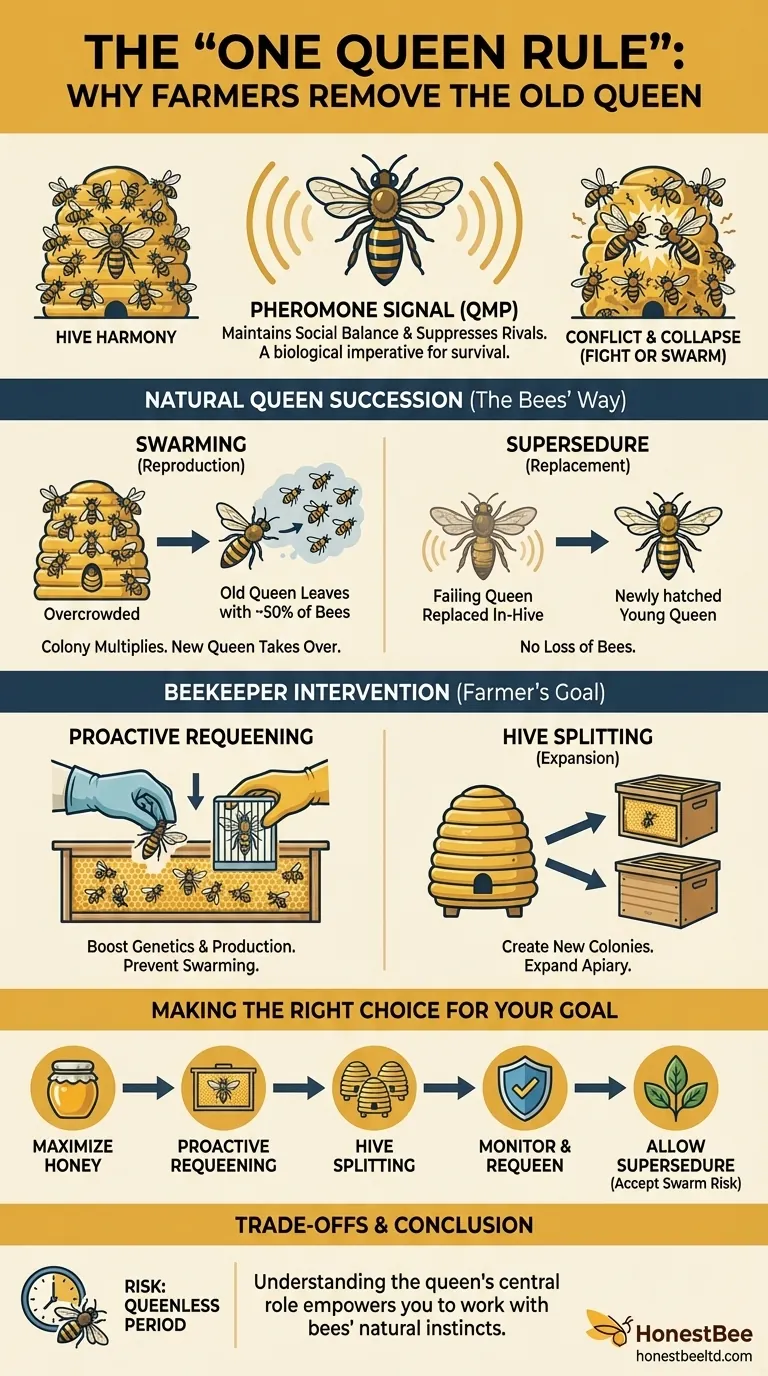In a honeybee colony, the old queen is removed—either by the bees or the beekeeper—because a hive can only sustain a single queen to function. The queen's unique pheromones act as the central organizing signal for the entire colony, and the presence of a second queen creates a conflict that will lead to a fight to the death, a hive split (swarming), or total social collapse. This "one queen rule" is a biological imperative for the colony's survival.
The core issue is not simply about replacing an old queen, but about maintaining the delicate social and chemical balance of the hive. A colony's stability, productivity, and very existence depend on having a single, recognized queen whose chemical signals guide all activity.

The "One Queen Rule": A Biological Imperative
A healthy honeybee colony is a superorganism that functions as a single entity. The queen bee is not a ruler who gives orders, but the reproductive heart and chemical center of this organism.
The Power of Queen Pheromones
The queen continuously produces a unique chemical signature known as the Queen Mandibular Pheromone (QMP). This scent spreads throughout the hive as worker bees tend to her and interact with each other.
This pheromone signal accomplishes several critical tasks: it suppresses the reproductive urges of worker bees, signals to the colony that they have a healthy and viable queen, and prevents the workers from raising a new queen.
When the Signal Weakens
The bees will decide to create a new queen for two primary reasons: swarming or supersedure. In both cases, the decision is triggered by a change in the queen's pheromone signal.
If the hive becomes too large and congested, the queen's pheromones can't reach all the bees effectively. If the queen becomes old, injured, or runs low on stored sperm, the potency of her pheromones diminishes, signaling to the workers that she is failing.
Natural Queen Succession: How Bees Manage the Transition
Before a beekeeper ever gets involved, the bees have their own sophisticated methods for managing queen succession. Understanding these is key to understanding beekeeper actions.
Scenario 1: Swarming
Swarming is the colony's natural method of reproduction. When the hive is strong and overcrowded, the workers raise several new queens in specialized "queen cells."
Just before the new queens hatch, the old queen will leave the hive, taking about half of the worker bees with her. This swarm then finds a new home, effectively creating a new colony. The first new queen to hatch in the original hive will kill her unhatched sisters and take over her mother's role.
Scenario 2: Supersedure
Supersedure is a direct replacement, not a reproductive act. When the bees sense their queen is failing due to age or injury, they raise a small number of replacement queens.
Once the new queen hatches and successfully mates, she will typically seek out and kill the old queen. In some cases, the worker bees will "ball" and kill the old queen themselves, recognizing the superiority of the new one. This ensures a seamless transfer of power without losing half the workforce.
Beekeeper Intervention: The "Why" Behind Requeening
While bees can manage this process, beekeepers (or "farmers") often intervene to achieve specific goals, such as boosting productivity or preventing the loss of bees.
Proactive Requeening
A beekeeper may choose to requeen a hive proactively. They will manually find and remove the old queen and introduce a new, young queen purchased from a breeder.
This is done to improve genetics (e.g., for gentler behavior or better disease resistance), ensure peak egg-laying for maximum honey production, and to prevent the hive from swarming, which drastically reduces the honey harvest.
Hive Splitting
As mentioned in the reference material, beekeepers also create new queens to expand their number of colonies. This is called splitting.
A beekeeper removes frames of eggs, larvae, and nurse bees from a strong hive—leaving the old queen in her original home—and places them in a new box. Because this new colony is now queenless, the workers are immediately triggered to raise a new queen from the eggs provided.
Understanding the Trade-offs
Managing the queen is the most critical and delicate part of beekeeping, and every choice has consequences.
The Risk of a Queenless Period
Whether through swarming or a failed requeening, any period without a laying queen is dangerous. If the new queen is killed on her mating flight or fails to mate properly, the entire colony will eventually die out as it has no way to create new bees.
The Cost of Intervention
Introducing a new queen isn't always successful. The colony may reject and kill her, viewing her as an invader. This intervention can be stressful for the hive and represents a financial cost to the beekeeper.
The Cost of Inaction
Allowing a hive to swarm means the beekeeper loses half of their workforce and the primary honey-gathering force for the season. Allowing a failing queen to remain too long leads to a weak, unproductive hive that is more susceptible to disease and collapse.
Making the Right Choice for Your Goal
The decision to remove a queen is always tied to a specific management goal for the hive.
- If your primary focus is maximizing honey production: Proactively requeening with a young, vigorous queen every 1-2 years is the most effective strategy.
- If your primary focus is increasing the number of colonies: Splitting the hive allows you to leverage the bees' natural queen-rearing instincts to create new, healthy hives.
- If your primary focus is preserving bees and preventing swarming: Carefully monitoring the hive and requeening a failing queen before the bees do is the best approach.
- If your primary focus is mimicking natural processes: Allowing the bees to supersede their queen on their own is the most hands-off method, but requires accepting the risk of swarming.
Ultimately, understanding the central role of the queen empowers you to work with the bees' natural instincts, not against them.
Summary Table:
| Scenario | Action | Outcome |
|---|---|---|
| Swarming | Old queen leaves with half the bees. | Natural colony reproduction. |
| Supersedure | Bees raise a new queen to replace a failing one. | In-hive replacement; no loss of bees. |
| Beekeeper Requeening | Beekeeper manually removes old queen. | Improved genetics & honey production. |
| Hive Splitting | Beekeeper creates a new, queenless colony. | Expands apiary by creating a new hive. |
Master Hive Management with the Right Equipment
Understanding queen succession is just one part of successful apiary management. Having reliable, high-quality beekeeping supplies is fundamental to supporting your hives through these critical transitions, whether you're a commercial apiary or a beekeeping equipment distributor.
HONESTBEE supplies the essential tools you need—from hive tools and queen excluders to protective gear and honey extraction systems—through our wholesale-focused operations. We help you work with the bees' natural instincts to maximize productivity and colony health.
Ready to equip your operation for success? Contact our team today to discuss your wholesale needs and discover how HONESTBEE can support your beekeeping goals.
Visual Guide

Related Products
- Professional Multi-Functional Queen Bee Cage
- Multi-Function Queen Roller Cage and Catcher
- Durable Galvanized Steel Spring Queen Bee Cage
- Professional Multi-Compartment Queen Cage with Sliding Lid
- Professional Queen Cage with Sliding Gate and Feeder Plug
People Also Ask
- What should be done before removing the queen cage from the hive? Ensure Your New Queen is Accepted & Laying
- How long does it typically take bees to adjust to a new queen? Master the 2-7 Day Acceptance Window
- What are common mistakes to avoid when using queen cages? Ensure Successful Queen Introduction
- How do you check if the queen has been released after installation? A Guide to Successful Queen Acceptance
- How should a queen cage be maintained over time? Ensure Queen Introduction Success



















